Art & Exhibitions
Vienna Gallery Beat: Seven Must-See Shows in May
We review the best of Vienna Gallery Weekend.
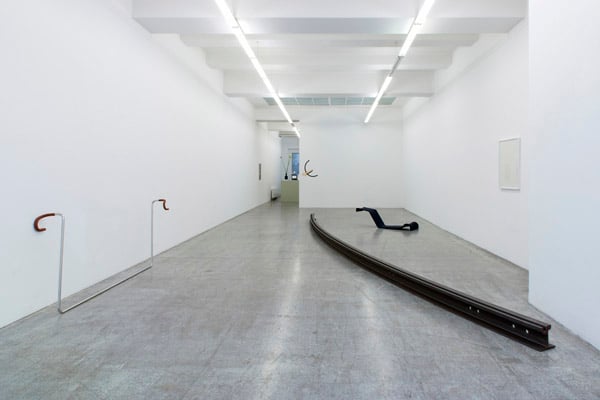
We review the best of Vienna Gallery Weekend.

Alexander Forbes

Eva Grubinger, “Café Nihilismus,” Kerstin Engholm Galerie. Through June 21
At the turn of the 20th century Vienna’s cafés were abuzz with life and thought. Tech was producing wealth at an ever greater pace yet leaving many behind in a widening income gap. The condition is no stranger to our current day save perhaps the swap of Café Central for Starbucks. “Café Nihilimus,” a yellow neon reads as one enters the gallery, an oblique reference to Ludwig Hevesi’s name for Vienna’s Café Museum—and undoubtedly stimulants’ inflationary effects on their consumers’ self importance. Inside is a graveyard of café furniture favorites: a marble tabletop mashes a mink’s tail into the concrete floor [Café Nihilismus(Round Marble) (2014)] and a fragment of a Thonet chair dangles mid-air, its seat cut in half [Café Nihilismus (Thonet) (2014)]. A single tramway rail curves gently throughout the gallery’s main room [Café Nihilismus (Tram Track) (2014)]. In isolation it’s an elegant homage to minimalist sculpture. But it creates a less pleasing chord when taken in concert with its exhibition partners and the circular, or at least spiraling, social track taken in the west over the past hundred years.
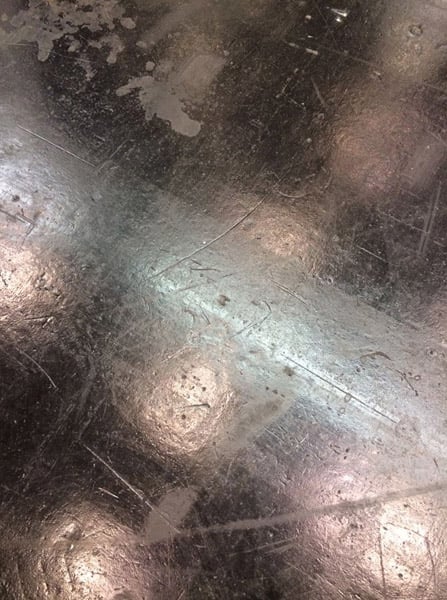
Karin Sander, 50.943246, 6.979001, 52m; 09.04.2014 14:42:04 (2014)
Photo: Courtesy Galerie nächst St. Stephan Rosemarie Schwarzwälder
Karin Sander, “Call Shots,” Galerie Nächst St. Stephan Rosemarie Schwarzwälder. Through June 18
The naïve entrant into Sander’s fifth show with the gallery might think she’s embarked on a project of creating the world’s most banal take on the 365 Project. The 45 initial photographs that hang chronologically throughout three of Schwarzwälder’s rooms take various, mostly indistinguishable, floors and Sander’s desk and feet as their main subjects. But, this is of course a red herring. The works, like most of Sander’s output, are created through a strict set of what she calls Spielregeln (playing rules). This time, she’s turned to tech: an app loaded onto her Android phone which has hacked it such that every time she accepts a call, a photo is taken and saved. (Sander says she and an app-developing collector tried to do it first with her iPhone, but they couldn’t break through the OS.) The unedited or resized results are then printed, framed, and hung on the gallery wall, a process, which will continue throughout the exhibition’s run. Each work is titled with the time at which and GPS coordinates where they were taken. Much can be gleaned from the process. Questions of authorship are certainly paramount, a theme increasingly central to Sander’s work since her exhibition “Zeigen” at Berlin’s Temporäre Kunsthalle in 2009, a series of multi-artist sound projects that was recast in Copenhagen last year. There’s the nice idea of memorializing moments of relative non-activity preceding a potentially memory-creating event. And, certain photos’ resemblance to the work of other artists—Thomas Demand’s models and certain series of Thomas Ruff’s abstractions are recalled—highlights a compelling sameness from the raw material from which certain sets of artists might cull their inspiration. But it’s the stark banality of the images that I can’t shake. It recalls too sharply lives lived in boxes with their own socially- and economically-born Spielregeln and only exited every so often, then with cameras pointed purposefully to justify the normal state of play.
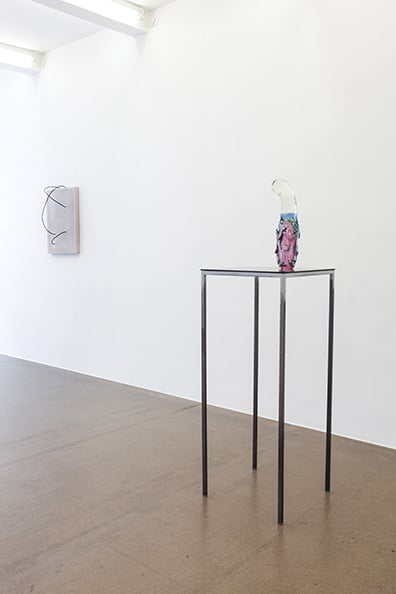
Installation View, Ursula Mayer, “Robotic Cells,” Galerie Krobath, Vienna
Photo: Courtesy Galerie Krobath
Ursula Mayer, “Robotic Cells,” Galerie Krobath. Through June 5
Rarely have sculptures been so seductive yet so disgusting. Three of these forearm-length, slightly lumpy, clear and colored glass structures lay on plinths staggered throughout the gallery. One stands next to the rearmost plinth at attention. Utterly abstract, they recall crystalline fetuses of pre-formed humans, masochistic dildos, or creatures of the oceans’ deepest reaches. Recesses in their rear ends remind of wine bottles. Their surfaces retain a remarkable fluidity, as if—like the cyborgic world between object and being that they represent—they might wriggle away from their posts like so many giant slugs. Notably absent from the exhibition is one of Mayer’s filmic works, much hyped of late. But the post-feminist artist takes an equally notable turn in the six wall sculptures on view, which see black electrical wires, easily mistaken for iron from afar, cascade out of and down concrete slabs. Arte Povera and Zero are quick aesthetic touch points here, but the conceptual effect is rather different: as if the walls themselves have gained some life force and, like an electricity-hungry form of kudzu are reaching out for some current on which to latch.
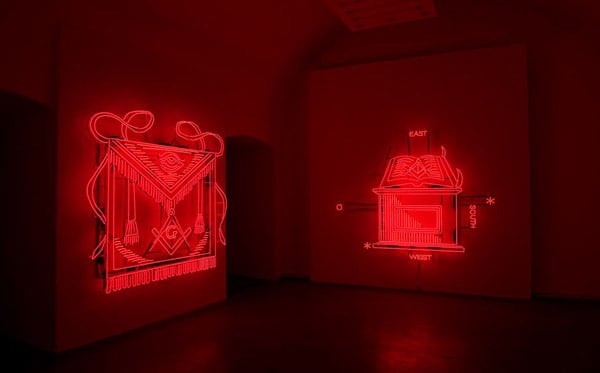
Joanna Rajkowska, The Light of the Lodge (2012)
Photo: © Joanna Rajkowska, courtesy Charim Galerie Wien
Joanna Rajkowska, “The Light of the Lodge,” Charim Galerie Wien. Through June 7
Europe goes on trial in Rajkowska’s show that sees the gallery turned into a surrealistic, hellish freemason lodge. (The rooms themselves once served as one of Vienna’s most important lodges.) Two large neons depicting freemason altars cast a bright red glow throughout the space. A video in the same room documents the show’s titular performance from 2012 in Copenhagen, which began the series of works. In it she, along with a hoard of women, roamed the city’s streets in robes and conical hats with fuel-dipped tips set alight. The gallery’s rearmost room features a carpet, The Blueprint (2014) which distorts the signature checkerboard floors of freemason lodges into a sort of Op-Art. There’s no questioning the read it offers. The mason’s enlightenment-driven ideologies of education, charity, and unity on which Europe (and particularly the EU) was built is obviously now broken. What’s worse? Neither Rajkowska nor the legions in Brussels knows how to fix.
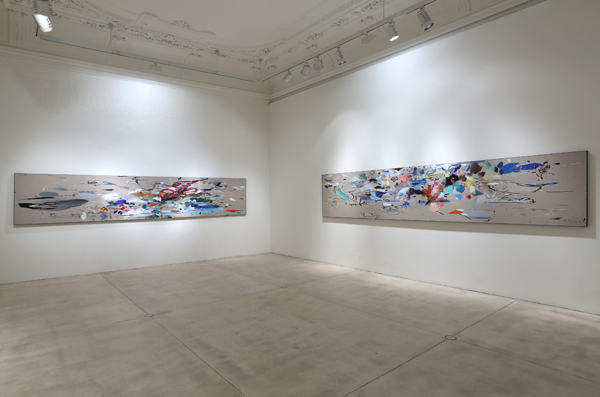
Installation View, Secundino Hernandez “Four Seasons Between Winter and Spring,” Galerie Krinzinger
Photo: Courtesy Galerie Krinzinger
Secundino Hernandez, “Four Seasons Between Winter and Spring,” Galerie Krinzinger. Through June 14
Sitting in Berlin a year ago, Secundino told me he wanted to recreate Poussin’s The Four Seasons for his Vienna show. The current market darling is a rather enthusiastic guy and a painter typically more interested in postwar Spanish art (with some impressionism and action painting thrown in for good measure) than masters of the French renaissance. I’d completely forgotten the plan until walking into the gallery—he’s pulled it off with the result some of Hernandez’s best work yet. With the exception of two works (all in the show are untitled and from 2014), Secundino has ditched his usual large-format portrait-oriented canvases for short, horizontal pieces ranging from three to nearly five meters in length, a format perhaps most redolent of David Reed. It allows for a narrative, timeline-like read of the works and forces a reduction and concentration of his brush strokes. They remain quite expressive in their lines and forms—blots of color on the largest quartet also recall the artist’s previous ‘palette paintings’ on which he meticulously accumulated hunks of every color of oil being used in the studio at a particular time. But the new format accentuates the intentionality behind his compositions and moves the artist definitively out of any purgatory of aesthetically pleasing, market-friendly hype and into the category of important art.
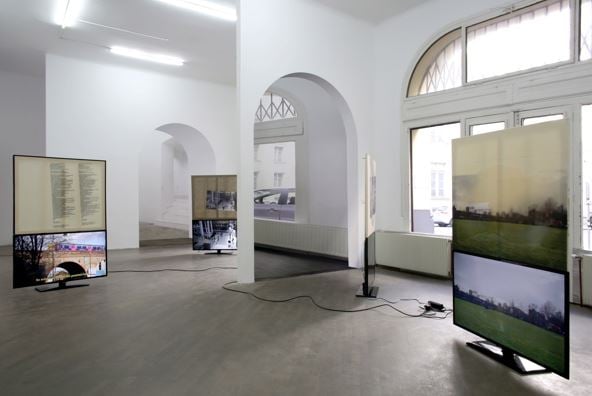
Philipp Timischl, “Yet, The Alternatives On Offer,” Galerie Emanuel Layr, 2014
Photo: Courtesy Galerie Emanuel Layr
Philipp Timischl, “Yet, The Alternatives On Offer,” Galerie Emanuel Layr. Through June 21.
Timischl has all the makings of an important young artist in the making. He’s ambitious: the works on view at Emanuel Layr are simultaneously sculptures, videos, photographs, and paintings. Flatscreens play footage that looks like it’s been captured on a phone camera and have canvases mounted to their tops like a static, second screen which only shows one or two frames from the video or a transcript of its conversation, maybe with some clear epoxy hardened in a puddle on top to boot. And, he’s spatially and architecturally engaged: those works are placed within a gallery with walls covered in indecipherable images of his previous shows and shots of Paris and London. The images are only reconcilable to the eye through a camera lens at which point the arches of Layr’s rooms appear to open up to other locales like magic portals, totally disrupting the space.
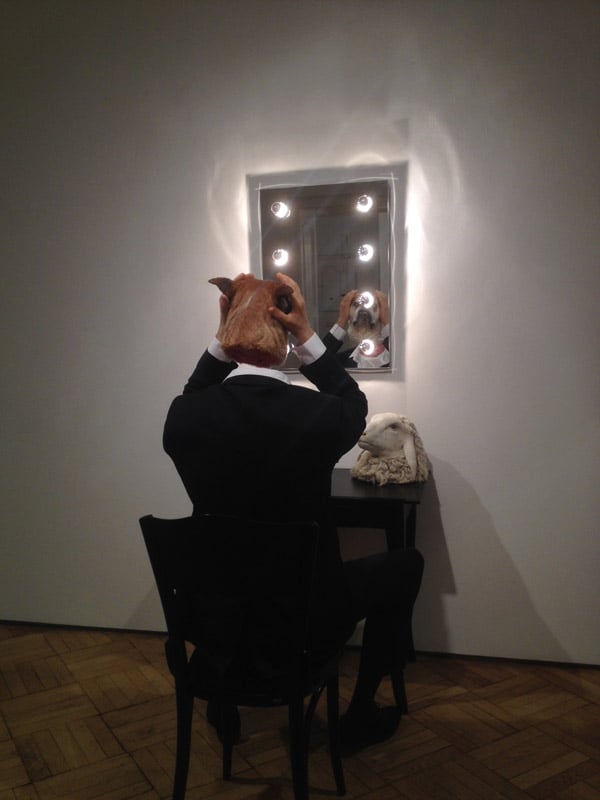
Deborah Sengl, “And Cut!” Galerie Ernst Hilger
Photo: © Alexander Forbes
Deborah Sengl, “And Cut!” Galerie Ernst Hilger. Through June 21
Sengl’s is a significant contribution to the genre of puppy art work. It’s perhaps easily laughed off as sordid kitsch. But don’t fall into the trap; give it a second look. A terrier’s head peers out of a child’s Teletubby costume and an eminently trendy pug plays a rather grouchy looking lion in her Little Darling Baby series of works on paper (all 2012). The show’s titular, sculptural work sees a wax actor in front of a vanity and with his back to the gallery’s entrance, swapping out a taxidermic bulldog’s head for that of a sheep. Her newest drawings Über Ich (2014) feature a greater variety of species dressed up in guises varied from “alcoholic” to “business man”. She says the work is about identity. But trauma is what really comes to mind.